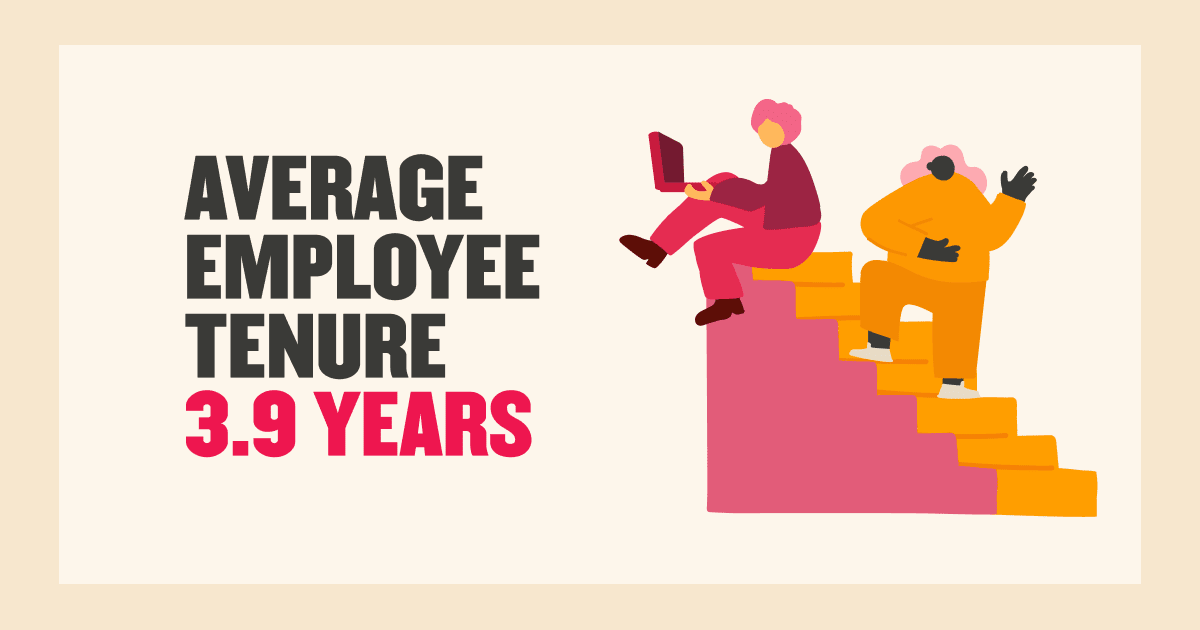Employee tenure, or job tenure, is the length of time a person has worked for a particular employer.
Employee tenure is more than just a measure of how long people stay at a company—it’s a window into workforce stability and team member engagement. While longer tenures can indicate strong alignment with company culture, shorter ones often bring new ideas and energy. Both are valuable, making it important for HR teams to understand the nuances of tenure and how it shapes their organization.
Analyzing employee retention helps HR leaders uncover opportunities to create a balanced workforce—one that values both seasoned professionals and fresh talent. In this article, we’ll explore the meaning of employee tenure, its types, and how it impacts organizational success.
<<The guide to being a great HR leader! Get the guide.>>

Employee tenure meaning
Employee tenure, or job tenure, is the length of time a person has worked for a particular employer. Some employers view tenure as an essential criterion for hiring new people.
Types of job tenure
HR professionals usually categorize job tenure into two groups: long and short.
- Long tenure: Long tenure is defined as five years or more with a single employer
- Short tenure: Two years or fewer with a single employer is considered by most to be short tenure
What is an average employee tenure?
According to the US Bureau of Labor Statistics, the average tenure was 3.9 years in 2024. There are several factors that affect employee tenure, including age and industry. Younger people tend to change jobs more frequently than older people. People working in service industries usually have lower tenure than those in law, architecture, and engineering occupations.

How long is a good tenure?
A “good” tenure depends on the context. For many organizations, a tenure of three to five years is often viewed as a strong indicator of stability and meaningful contribution.
In fast-moving industries like technology or hospitality, shorter tenures of one to three years are common and may still reflect valuable experience. On the other hand, in sectors where deep expertise and continuity matter—such as government or education—longer tenures, often five to 10 years or more, demonstrate commitment and deeper engagement with the organization’s goals.
Average tenure across industries
The length of tenure can shift significantly depending on the industry. These numbers highlight how the nature of the work and the demands of specific industries influence how long people stay with their employers.
Here’s a closer look at averages drawn from the US Bureau of Labor Statistics:
- Construction: 4.2 years
- Agriculture: 4.4 years
- Real estate: 4.4 years
- Finance: 4.9 years
- Education: 3.6 years
- Government: 6.2 years
Why is tenure important?
Job tenure is one factor that may give HR professionals insight into a person’s character and suitability for a job. While it’s not always true, some see employee tenure as an indicator of a person’s quality as an employee. Staying longer with a particular employer can indicate qualities like loyalty, stability, commitment, and focus. It also indicates that a person has had time to build expertise in their field.
That being said, shorter tenure does not necessarily mean a person lacks expertise or commitment. There are many reasons why somebody may leave a job, including compensation, job satisfaction, personal reasons, and a mismatch between the person and their role.

Difference between tenure and seniority
While tenure and seniority are often used together in conversations about career progression, they’re not the same. Both are valuable in understanding a person’s professional experience, but they highlight different aspects of their journey within an organization, such as:
- Measuring time vs rank: Tenure measures how long someone has worked for an organization. Seniority reflects a person’s rank, influence, or level of responsibility within the company.
- Loyalty vs positions held: Tenure is often seen as a marker of loyalty and stability. Seniority, on the other hand, highlights professional growth and achievements.
Understanding the difference between tenure and seniority allows HR professionals to evaluate both the experience someone brings and the impact they’ve made during their career.
How to calculate tenure
Whether you’re looking at an individual’s work history or analyzing team-wide trends, here’s how to calculate tenure.
Recommended For Further Reading
1. Establish a start and end date
Identify the team member’s start date with the company. If they’ve already left, use their last working day as the end date. If they’re still employed, use today’s date.
Example:
- Start date: January 1, 2018
- End date: December 31, 2024 (or today’s date for current team members)
2. Determine the number of days of employment
Calculate the total days between the start and end dates. You can use a date calculator or spreadsheet software to make this step quick and accurate.
Example:
- From January 1, 2018, to December 31, 2024, there are 2,555 days.
3. Convert into years or months
Divide the total number of days by 365 to convert the employment period into years or months to make it easier to interpret and compare.
Example:
- 2,555 ÷ 365 = 7 years (rounded to the nearest whole number).
By following these steps, you’ll have a clear, consistent way to calculate tenure that works for both individual team members and broader workforce analysis.
4. Calculate average employee tenure
The average tenure of employees at a company represents the typical length of time all people have remained, offering insights into workforce stability and retention. To calculate average tenure, add together the total amount of time each current team member has been employed (in years, months, or days), then divide that sum by the total number of all team members.
Example:
Let’s say a company has five team members with the following lengths of service:
- Person A: 3 years
- Person B: 5 years
- Person C: 2 years
- Person D: 4 years
- Person E: 6 years
The total combined tenure in this scenario would be 20 years.
- Average tenure = 20 years ÷ 5 people = 4 years

Advantages of long job tenure
Long-tenured employees bring significant value to organizations in multiple ways.
- Enhanced loyalty and commitment: People who stay with a company for extended periods typically demonstrate stronger loyalty to the organization’s mission and values. This commitment often translates to greater dedication during challenging times and a willingness to go above and beyond standard responsibilities.
- Deep institutional knowledge: Long-tenured team members accumulate valuable historical context and specialized expertise that can’t be easily replaced. They understand not just how processes work, but why they were implemented, making them invaluable resources for problem-solving and mentoring.
- Reduced recruitment and training costs: Higher retention rates directly impact the bottom line by minimizing expenses associated with hiring, onboarding, and training new staff. Studies suggest replacing a person can cost between six to nine months of their annual salary.
- Established professional networks: Over time, team members develop extensive internal and external relationships that benefit the organization. These curated networks facilitate smoother collaborations, faster problem resolution, and even business development opportunities.
- Increased productivity and efficiency: Familiarity with systems, processes, and organizational culture allows long-tenured people to work more efficiently. They require less supervision and can navigate complex situations with greater confidence and speed.
- Enhanced company reputation: Organizations with high retention rates often enjoy stronger employer branding and customer trust. Long-tenured staff signal stability and reliability to external stakeholders.
- Cultural continuity: Veteran team members can serve as cultural ambassadors who help maintain and transmit company values and traditions to newer team members, preserving organizational identity through periods of change.

Disadvantages of long job tenure
While long-tenured employees bring valuable stability and expertise, extended periods with the same employer can present challenges for both individuals and organizations.
- Limited learning and growth: People who remain in the same role for many years may experience fewer opportunities to develop new skills or be exposed to diverse challenges.
- Career advancement plateaus: Organizations with limited hierarchical structures may not offer sufficient promotion opportunities for long-tenured employees. Without clear pathways for advancement, talented team members may feel their careers have hit a ceiling despite their loyalty and contributions.
- Complacency and reduced innovation: Familiarity with existing processes can lead to a “this is how we’ve always done it” mentality. Long-tenured people might become resistant to change or less likely to suggest innovative approaches.
- Decreased engagement and burnout: Without new challenges or changes in responsibilities, team members may experience diminished enthusiasm for their work over time. This can manifest as reduced productivity, increased absenteeism, or burnout.
- Succession planning challenges: Organizations with numerous long-tenured employees in key positions may face difficulties developing clear succession plans. When these experienced team members eventually leave, their departure can create significant knowledge gaps and operational disruptions.
- Compensation compression: Long-tenured team members may experience salary stagnation if their compensation increases fail to keep pace with market rates. This can create situations where new hires earn comparable or even higher salaries than loyal, experienced staff.
Understanding these potential drawbacks helps HR professionals develop strategies that maximize the benefits of loyalty while mitigating the risks associated with extended tenure. Creating opportunities for internal mobility, continuous learning, and meaningful recognition can help long-tenured team members remain engaged and continue adding value to the organization.
Key takeaways
- Employee tenure refers to the duration a person works with a particular employer, categorized into long and short tenure
- The average tenure in the United States was 3.9 years as of 2024, according to the US Bureau of Labor Statistics
- Long tenure, defined as five years or more, often indicates loyalty, stability, and expertise, while short tenure, two years or fewer, can result from various factors such as career growth or personal reasons
- Understanding tenure is crucial for HR professionals in making informed hiring decisions, assessing job satisfaction, and planning workforce strategies
- Academic tenure differs in that it provides professors with job security after demonstrating commitment to their institution
- Both long and short tenures offer unique advantages and challenges, influencing organizational culture and team member development
Include employee tenure as part of your modern HR strategy
The employee lifecycle naturally terminates with separation, meaning that people of any employee type will eventually move on from their current employer. But the length of time a person stays at a single organization (their tenure) can indicate many things, including the depth of their expertise and loyalty to their employer. As an HR professional, paying attention to a person’s average tenure at a job is one way to learn a bit more about them to help you make hiring decisions.
Employee tenure FAQs
What is academic tenure?
In academia, the word tenure is used slightly differently than it is in HR, sometimes confusing people as to the term’s actual meaning. As opposed to the definition of tenure we’ve given above, academic tenure is a distinction that a professor can receive after they’ve demonstrated their commitment to their role and institution. When a professor gets tenure, they have a certain type of job security in which their employer cannot terminate them except in extreme situations.
The term is also used in the context of tenure track positions, a progression of job promotions from assistant professor to associate professor to professor.
What is an example of employee tenure?
An example of employee tenure could be a marketing professional who has worked at the same company for eight years. Their tenure reflects not only the time they’ve contributed to the organization but also their deep understanding of its goals, culture, and processes.
Can a tenured employee be fired?
Yes, a tenured person can be fired, but it’s typically more complex than terminating someone without tenure. In academia, for instance, a tenured professor may only be dismissed for significant reasons like gross misconduct or serious violations of institutional policies. Outside academia, tenure doesn’t guarantee absolute job security. However, it often comes with added protections, such as progressive discipline policies or longer notice periods. Employers should exercise care when addressing performance or misconduct issues for long-tenured team members to ensure fairness and maintain trust.
How long do employees typically stay at a job?
On average, employees in the United States stay with their employer for about 3.9 years. However, this number varies significantly depending on factors like age and industry. For example, younger professionals may stay just two to three years as they explore different opportunities, while older professionals often remain with an employer for longer periods. Similarly, industries like hospitality and retail tend to see shorter tenures, while government or education roles report much higher averages.
Is long tenure better?
Long tenure has its advantages, but whether it’s “better” depends on the context. Employees with longer tenure often bring loyalty, institutional knowledge, and expertise to their roles. However, long tenure isn’t always ideal—it can sometimes lead to stagnation, reduced innovation, or resistance to change. A healthy balance is key. Organizations benefit when they retain experienced team members while also welcoming fresh perspectives. Ultimately, tenure is just one piece of the puzzle—it’s the quality of contributions that matters most.
